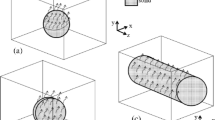Abstract
This paper discusses the use of the topology optimization formulation for designing a heat dissipating structure that utilizes forced convective heat transfer. In addition to forced convection, there is also natural convection due to natural buoyancy forces induced by local heating inside fluid. In the present study, the temperature distribution due to forced convection, neglecting buoyancy and viscous dissipation inside fluid, was simulated and optimized. In order to analyze the heat transfer equation with forced convective heat loss and the Navier-Stokes equation, a common sequential computational procedure for this thermo/hydraulic characteristic was implemented. For topology optimization, four material properties were interpolated with respect to spatially defined density design variables: the inverse permeability in the Navier-Stokes equation, the conductivity, density, and the specific heat capacity of the heat transfer equation. From numerical examples, it was found that the balance between the conduction and convection of fluid is of central importance to the design of heat dissipating structures.
Similar content being viewed by others
References
M. P. Bendsøe and O. Sigmund, Topology Optimization Theory, Methods and Applications, Springer-Verlag, (2003).
G. H, Yoon and Y. Y. Kim, The element connectivity parameterization formulation for the topology design optimization of multiphysics systems, International Journal for Numerical Methods in Engineering, 64 (2005) 1649–1677.
G. H. Yoon, J. S. Jensen and O. Sigmund, Topology Optimization of Acoustic-Structure Interaction Problems using a Mixed Finite Element Formulation, International Journal for Numerical Methods in Engineering, 70 (2007) 1049–1076.
G. H. Yoon and O. Sigmund, A monolithic approach for electrostatic problems, Computer Methods in Applied Mechanics and Engineering, 197(45–48) (2008) 4062–4075.
G. H. Yoon, Topology optimization for stationary fluid-structure interaction problems using a new monolithic formulation, International journal for numerical methods in engineering, 82 (2010) 591–616.
R. D. Cook, D. S. Malkus, M. E. Plesha and R. J. Witt, Concepts and applications of finite element analysis. John Wiley & Sons, USA, 4th Edition, (2001).
K. J. Bathe, Finite element procedures. Prentice hall, New Jersey, (1996).
Frank M. White, Fluid Mechanics, McGraw Hill International Edition, (1994).
P. I. Frank, P. E. W. David, Introduction to heat transfer, Wiley, (1990).
S. C. Lin, F. S. Chuang and C. A. Chou, Experimental study of the heat sink assembly with oblique straight fins, Exp. Therm. Fluid Sci, 29 (2005) 591–600.
X. Yu, J. Feng, Q. Feng and Q. Weng, Development of a plate-pin fin heat sink and its performance comparisons with a plate fin heat sink, Appl. Therm. Eng., 25 (2005) 173–182.
M. A. Ismail, M. Z. Abdullah and M. A. Mujeebu, A CFD-based experimental analysis on the effect of free stream cooling on the performance of micro processor heat sinks, International Communications in Heat and Mass Transfer, 35 (2008) 771–778.
S. C. Lin and C. L. Huang, An integrated experimental and numerical study of forward-curved centrifugal fan, Experimental Thermal and Fluid Science, 26 (2002) 421–434.
M. V. D Bonis and G. Ruocco, A generalized conjugate model for forced convection drying based on an evaporative kinetics, Journal of Food Engineering, 89 (2008) 232–240.
P. Verboven, N. Scheerlinck, J. D. Baerdemaeker and B. M. Nicolaï, Computational fluid dynamics modelling and validation of the isothermal airflow in a forced convection oven, Journal of Food Engineering, 43(1) (2000) 41–53.
C. Xu and T. S. Zhao, A new flow field design for polymer electrolyte-based fuel cells, Electrochemistry Communications, 9 (2007) 497–503.
H. Luca, On the stability of the finite element immersed boundary method, Computer and structures, 86 (2008) 598–617.
O. Fridolin and B. Henrik, Design of microfluidic bioreactors using topology optimization, European conference on computational fluid dynamics, ECCOMAS CFD 2006 Netherlands.
T. Borrvall and J. Petersson, Topology optimization of fluids in stokes flow, International Journal for Numerical Methods in Fluids, 42 (2003) 77–107.
J. K. Guest and J. H. Prevost, Topology optimization of creeping fluid flows using a Darcy-Stokes finite element, International Journal for Numerical Methods in Fluids, 66 (2006) 461–484.
A. Gersborg-Hansen, O. Sigmund and R. B. Harber, Topology optimization of channel flow-problems, Structural and Multidisciplinary Optimization, 39(3) (2005) 181–192.
L. H. Olesen, F. Okkels and H. Bruus, A high-level programming-language implementation of topology optimization applied to steady-state Navier-Stokes flow, International Journal for Numerical Methods in Engineering, 65(7) (2006) 975–1001.
T. E. Bruns, Topology optimization of convectiondominated, steady-state heat transfer problems, Int. J. Heat and Mass Transfer, 50 (2007) 2859–2873.
W. Xiaodong, Analytical and computational approaches for some fluid-structure interaction analyses, Computer and structures, 72 (1999) 423–433.
P. O. Persson, Implementation of finite element-based navier-stokes solver, http://persson.berkeley.edu/pub/nsfem_report.pdf, (2002).
K. Svanberg, The method of moving asymptotes — a new method for structural optimization, International Journal for Numerical Methods in Engineering, 24 (1987) 359–373.
Author information
Authors and Affiliations
Corresponding author
Additional information
This paper was recommended for publication in revised form by Associate Editor Tae Hee Lee
Gil Ho Yoon is currently an Assistant professor at the mechanical department at the Kyungpook National University, Daegu, Korea. He focuses on structural optimization, multiphysics system, and nonlinear structures where he concentrates on optimization. He received a Ph.D. in school of mechanical and aerospace engineering from the Seoul National University in 2004, an MSc in 2000 and a BSc in 1998 from the same department and the same university.
Rights and permissions
About this article
Cite this article
Yoon, G.H. Topological design of heat dissipating structure with forced convective heat transfer. J Mech Sci Technol 24, 1225–1233 (2010). https://doi.org/10.1007/s12206-010-0328-1
Received:
Revised:
Accepted:
Published:
Issue Date:
DOI: https://doi.org/10.1007/s12206-010-0328-1




